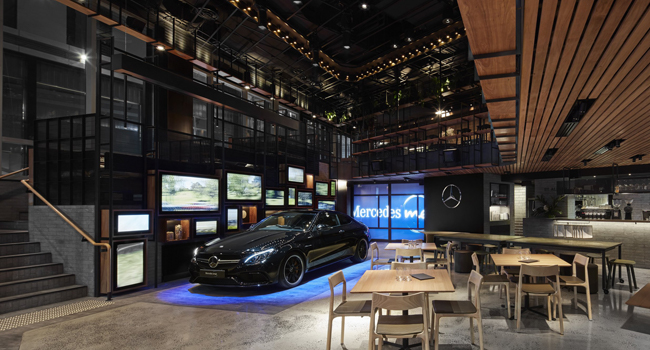The process of buying new cars is in an “evolution” stage. Consumers are expecting a different experience than they did only a few years ago.
We take a look at the changing environment of buying cars.
Key points
- The typical salesman ‘car yard sell’ is becoming less effective
- ‘Mercedes me’ offers a unique interaction with the brand
- Dealerships are a place of experience rather than a place of sales
- Exposure to a brand often happens online and is followed by research (also online)
- The results are difficult to measure but show customer loyalty
Overview
The days of the renowned Saturday morning car yard ‘to and fro’ sale appear to be coming to an end.
Many car buyers are familiar with this sales tactic from eager salespeople at dealerships, but the tactic is proving less effective in this new age world.
Consumers are focusing more on the experience of becoming a customer, rather simply purchasing a product and becoming a customer.
Common practices today include; allowing prospective customers to test drive vehicles overnight and in some cases, over a weekend.
Today’s car buyers also typically have significant exposure to brands online prior to even setting foot in a car dealership.
Mercedes me delivers a new kind of customer experience
Although temporarily closed at the time of writing due to the pandemic, Mercedes me in Melbourne is a totally revamped car dealership. It’s also a peek at where some OEM dealerships are headed.
Resembling more of an inner-city high end cafe & coffee bar than a car dealership, albeit with Mercedes-Benz logos clearly displayed, Mercedes me allows patrons to visit with minimal brand interaction.
 (The Mercedes me store delivers a top-tier brand experience. Source: cultdesign.com)
(The Mercedes me store delivers a top-tier brand experience. Source: cultdesign.com)
Note that we’re saying ‘patrons’, not ‘prospective customers’.
The atmosphere inside Mercedes me is inline with how the brand wants to be perceived. You’ll see clean lines in the layout design and colours of the cafe and seating area with no mismatching cutlery, chipped mugs or traffic noise.
Mercedes is aiming for Instagram moments rather than vehicle negotiations to give visitors a taste of what owning their products is like.
A Mercedes-Benz vehicle is the centrepiece of the main cafe space. Patrons are also gently reminded of the brand throughout the venue. For example, the ‘AMG Avocado’ and ‘Eggs Benz-edict’ on the food menu.
Visitors can also attend events such as live music, art shows and seminars.
There is minimal focus on vehicle sales, so much so that most staff are trained and experienced in restaurant service rather than cars.
The result is a unique and tailored experience with the brand as seen on food review websites rather than vehicle sales platforms.
Mercedes isn’t the only brand adopting changes
Shifting gears from pushing cars out the door to focusing on brand experience is not unique to Mercedes.
Tesla, Toyota and Porsche, among other brands, are also known for their ‘customer experience’ approach.
Depending on the location, showrooms act like ‘demonstration studios’ by allowing visitors to get a feel for the brand as well as the products.
For example, some Tesla dealerships offer no-obligation test drives and tech-heavy demonstrations using VR headsets.
Furthermore, unlike traditional car dealerships, Tesla (in most cases), does not pay salespeople commission and instead offer salaries.
Depending on the location, Tesla employs product experts and ‘advisors’ rather than salespeople. Staff are trained in the operation of vehicles and how to explain features to customers, rather than how to sell them.
This means a visitor to a Tesla dealership will often leave knowing all about the vehicles without any (or minimal) pressure to buy. They’ll make their decision in their own time, often online.
The ‘customer experience’ sales model
Although a generalisation, the steps below show a typical customer journey in today’s experience-focused new car purchase.
Exposure – this often begins online with high quality and targeted imagery or videos displayed by the manufacturer.
Research – again online, using third-party websites, a potential customer reads / watches reviews. Additionally, some may seek opinions from family and friends. This provides manufacturers with an opportunity to build trust.
Experience – at the dealership and at a manufacturer’s website. Customers experience a brand first hand, similarly to Mercedes me and Tesla’s approach above, they’ll be inspired to become a customer rather than pushed into a vehicle by a salesperson.
Decision – likely online, or at least in their own time, customers make a decision based on their experience with the brand backed by their own research.
After sales – to help referrals and online reviews / comments, after sales service is another key piece of the puzzle. This not only includes vehicle servicing, but also digital newsletters, event invitations (such as a webinar, new product launch, charity event) and automated emails (such as for birthdays or purchase anniversaries).
The results
Although it is difficult to peg sales numbers on the direct results of a great customer experience, it is evident that market leaders are focusing on the practice.
In the first six months of 2021, a total of 7,248 electric cars were sold in Australia. Of that number, around 5,000 were Tesla purchases – this was calculated based on figures of other EV sellers versus the total number of registrations as Tesla does not reveal numbers.
That means that Tesla is outselling the combined EVs of all competitors two to one.
These results are not indicative of the brand’s experience-based sales approach, but they do show Tesla is a leader in their industry.
Toyota, another automaker that prides itself on customer experience, is the most likely brand to be recommended by product owners in Australia. That’s out of all businesses from all industries, not just vehicles.
According to research and data analytics firm YouGov, considerations such as customer experience and brand values, found Toyota is likely to be recommended by 87.7% of owners.
Jack Daniels, La Roche Posay and Singapore Airlines were in second, third and fourth place respectively.
In summary
With so many major brands delivering high quality products at competitive prices, supported by extended warranties and capped price servicing, it’s difficult to make the ‘best car’.
In fact, many of the worst-rated cars today have fewer problems than the top-performing cars from just 10 years ago.
Instead, the battlefield is shifting more and more on customer experience and who can deliver the best journey – to a sale, not to the road.




